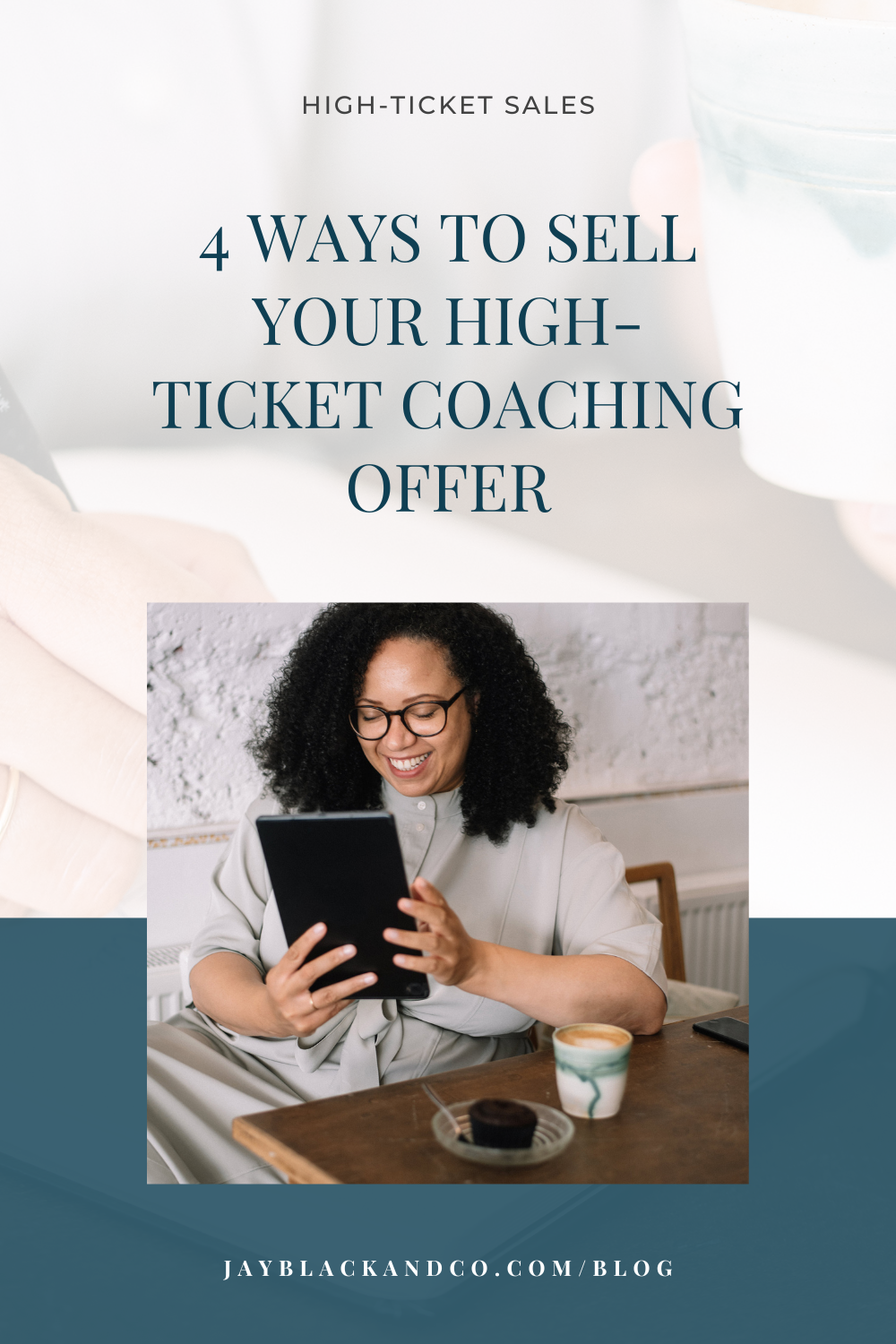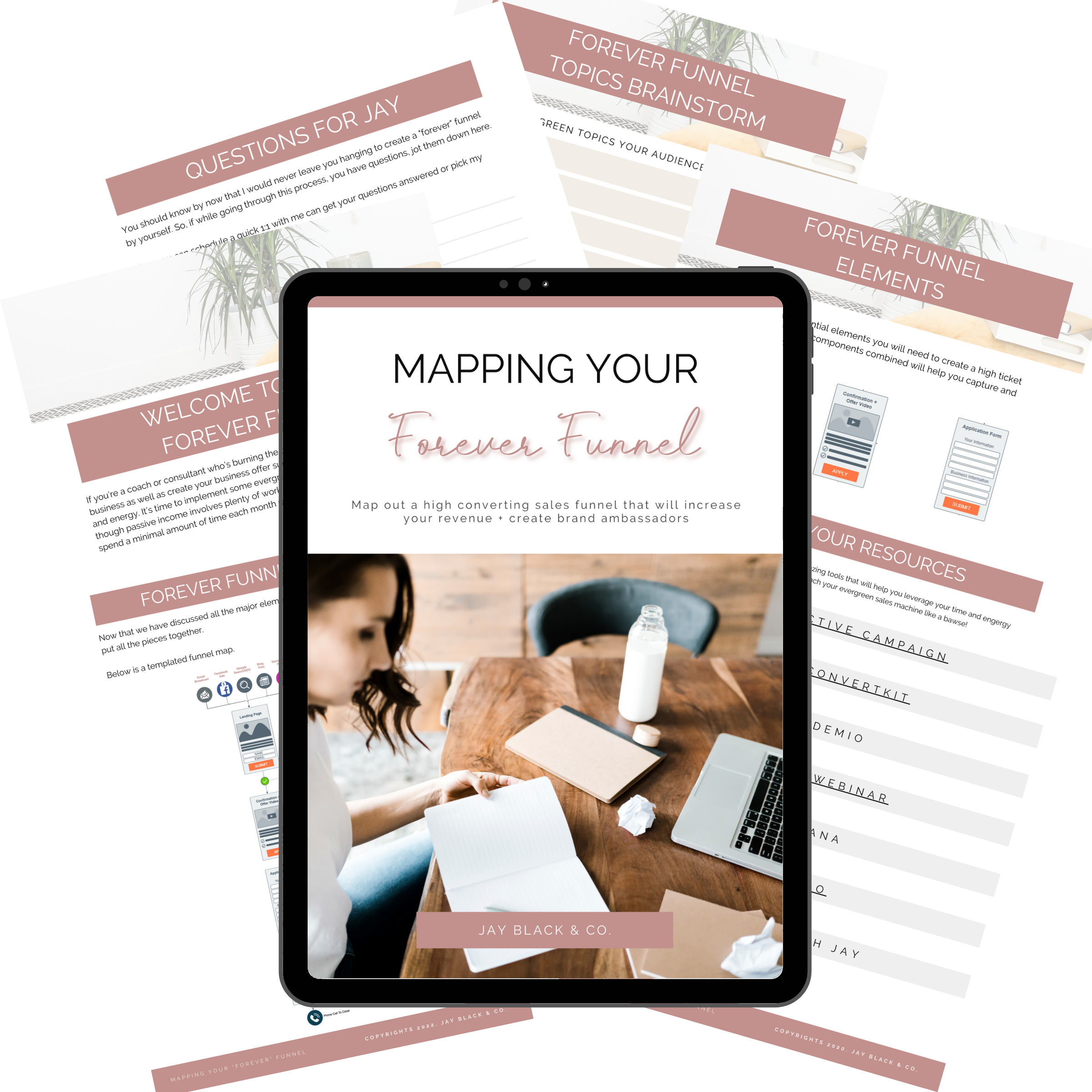There is a common challenge that all coaches, consultants, and service providers face daily. Unfortunately, it’s a challenge that many may see as a threat to the very existence of their business. If they cannot overcome this one thing, they tend to see themselves as failures and give up, throw in the towel, and exit stage left.
What is this challenge? It’s selling their high-ticket offer.
The inability to attract clients interested in this kind of offer or convert leads/prospects on sales calls leads many service providers to take drastic measures within their businesses that end up doing more harm than good.
Why is a high-ticket offer so hard to sell?
Before I answer that question, let’s first get on the same page about what a high-ticket offer is and how it fits into your business.
What is a High Ticket Offer
You might have heard this term in an online social group, mastermind, or a certification class. It simply means any service, program, or product offered at a premium price within your business. This would typically be one-on-one services, a mastermind, group coaching or consulting, a retreat, a program, or a course valued at over $2,000+.
This offer is top-tier, not in pricing alone. More must be included in this offer to be considered a high-ticketed offer. Your offer must have tons of quality value – not only to you as the business owner and expert, but more importantly, to your client. Your offer must effectively provide a transformation that will help your client achieve their ultimate goal if they properly apply your method, services, or techniques. You should be able to move them from point A (where they are currently) to point Z (where they desire to be).
So, what does this mean for your business?
A high-ticket offer can best leverage your time and energy. With just one offer, you can reach your revenue goals and help your clients achieve their goals more quickly. How so?
Let’s look at this from your client’s point of view first. (Since this is really about them and their transformation, right?)
With lower ticketed offers, a client might be able to overcome more minor hurdles to reach their goals. They are tackling smaller obstacles at a time, taking longer to get where they desire to be. They are limited in their progress because they may need more one-on-one support, access to resources or a community, tools, and more. Higher-ticketed offers will include these resources.
Now, as the expert and business owner, you can leverage your time more effectively. With a high-ticket offer, you can utilize your team and resources better. You can bring more people into your business because you can service more people and get them to their desired goals more quickly. In addition, you have access to your team to help you support your clients. And with that access, you will be able to step away from having to be hands-on with your business and clients.
Why a High-Ticket Offer Hard to Sell
After our previous discussion, it may seem that high-ticket offers should sell themselves. They should be a no-brainer, right? Well, that’s not always the case.
Many service professionals struggle with selling many of their high-ticket offers for several reasons. One huge challenge is the pricing. With an offer over $1,000, it’s harder to convince a person that it’s worth the investment. Even if you’ve built a relationship with your audience member, getting them to enter those sweet 16 digits from their credit card can be an uphill battle.
But, there are other challenges that service providers face when selling their high-ticket offers. Let’s talk about 3 of the most common ones.
Lack of knowledge of your ideal client. Don’t roll your eyes at this one. Nor should you underestimate the power of knowing your audience. Now, I don’t mean just knowing the demographics of your ideal clients (where they live, their age, sex, marital status, etc), I mean knowing the things that keep them up at night. The dialogue they have with their friends or with themselves. Knowing their deep pain, fear, frustration, hesitations, desires, and goals. You must know where they are in their pain when they come across your brand. You need to know what is the hook that’s going to captivate and intrigue them. Also, you must understand what’s required of their transformational journey – how they get from A to Z.
How do you find out this information? Conduct solid research. Interview possible leads or clients. Listen more than you talk. Observe what’s being said and what is not being said in online groups. Study. Study. Study.

Not clear on their brand promise. Once you know your ideal client’s transformational journey, know how this offer helps to facilitate that change. Where within that process does your service or program fit? What are the anticipated obstacles, seen and unseen, that your program helps them face and tackle?
It’s understanding that to get from A to Z, you must get to B, C, D, E, and so on. Then, it’s knowing that at point C, they will need a specific type of support or resource to get them to D.
If you are unclear on how your offer will help your client, you will lose their interest and even damage their trust in you as the expert.
Inability to articulate your offer’s value. At this point, it’s your job to answer the question of “WHY.” Why do they need your offer as opposed to someone else? Why is your approach to solving their problem so different from Susan’s down the virtual street?
You must confidently convince your audience that you ARE the expert and that your offer is unlike anyone else. You are the one to help them make their desired transformation. You have to address their objections head-on. You need to explain the benefits of your offer clearly.
If you understand your USP (unique selling proposition), their deep aspirations, fears, and challenges, and know how your offer can help them with their transformation, you can move to the next step to selling your high-ticket offer.
How to Sell Your High-Ticket Offer
Now that you have the foundational elements, you can bring your high-ticket offer to the masses. There are several ways that you can market your offer to your audience. For example, you can use social media, ads, networking, etc.
My clients and I have had tremendous success with each of these methods. However, not everyone may have the budget for a massive ad campaign, access to an area that hosts networking events, or a large social media presence. And, guess what? That’s okay.
I’m going to share with you 4 ways that you can effectively and successfully sell your high-ticket offer to your target audience.
Email Marketing
I believe that one of the most effective but highly underutilized methods of selling high-ticket offers is email marketing. With email marketing, you can pitch your high-ticket offer whenever you want, how often you want, and how you want. They are no rules here. Well, not a lot.
Your email list is filled with people who are interested in what you offer. They’ve already said that they wanted to hear more from you. They have raised their hands and said they want to be a part of your tribe. If you have spent time nurturing and engaging with your list, you can tell who’s anxious to start working with you. You can identify these people by looking at your engagement identifier (those who have opened your emails, clicked on links, responded to call-to-actions, etc.) You can segment those subscribers to a specialized list and focus your marketing efforts on them. Active Campaign is a great tool that I use for my email marketing and for a few of my clients. It makes identifying these qualifiers and segmenting them quick and easy.
Some of my clients have chosen to only launch specials for high-ticket offers to their segmented lists and have found it very lucrative. They’ve preferred to do this instead of marketing on social media.
Webinar
There is a reason why most coaches and consultants use webinars to sell their high-ticket offers. It’s because it works. Your audience can see, in real-time, your personality, your style of teaching, your methodology, and your expressions. They can feel you out and see if you’re a good fit for them and if you can get them where they want to be.
During your webinar, you can help open their eyes to possibilities they didn’t know existed. You can overcome objections, answer questions, and establish yourself as an expert on a given topic.
One of my clients was able to sell out her high-ticket program of $12,000 by simply hosting a free webinar which she used ads to drive traffic to that webinar. I must say that to reap these types of results, she spent thousands of dollars on ads. You may not have the budget to drive that amount of traffic to a webinar. And, guess what? That’s okay.
Enjoying Our Post but Have Questions?
If you're realizing that you need help composing or selling your high-ticket offer, we're here to help. We've helped over 600 clients successfully sell their high-ticket offers worldwide. Yours could be our next success!
You can reap the same results if you have an engaged audience and constantly communicate with them. With Jay Black and Co., I use Thrive Themes to establish my webinar funnels. I have full creative control over the experience those who are registering have. Using their automaton features makes registering for the webinar seamless and up levels the journey. To host my clients and my webinars, I love Demio. It’s easy to use, clean, and full of great features that won’t cost you an arm and a leg.
Sales Page
Some might read this and think it’s an obvious or given vehicle to sell your high-ticket offer. “Of course, you need a sales page!” you may say. And, you’re right. You definitely need a sale page. However, not everyone understands how impactful a sales page can be. It can be a deal breaker or a deal maker.
Here are a few elements your sales page needs to convert prospects into clients quickly and consistently – in no particular order.
- Headline
- Clearly defined problem and solution
- Call-to-action (CTA)
- Testimonials/social proof
- Story-telling copy
- Pricing details
- FAQs
- Quality offer images
- Automated order funnel
- Guarantee
I will break each of these elements down in a separate post.
To create dynamic and high-converting sales pages, I use Thrive Themes. It’s sleek, easy to use, and allows me to create customized modern sales pages. With their drag and drop feature, I’m able to design these pages in no time.
Referrals
When I mentioned this to one of my clients, she asked, “can I really build my business on just referrals?” My reply to her is a resounding YES! I built it solely from referrals for the first 10+ years of my business. And, I’m talking about selling out my client slots of one-on-one services with packages priced between $2,500-7,500/month.
So, what’s needed to onboard more clients through referrals?
A formal client referral program will do the heavy lifting when communicating with those who refer you and those who meet you through a referral. A referral program is relatively easy to set up within your business. There are just a few components that you need to have in place.
- Determine the offer
- Build a referral list of previous clients, colleagues, and friends to reach out to
- Determine your incentive
- Create a referral message
- Setup your referral tracking system
- Write ‘Thank You’ emails
- Create a followup funnel
To start your referral program, you don’t need any fancy software. I’ve had clients use everything from Google Sheets to their CRM. I love using 17Hats for housing, tracking, and communicating my referrals. For incentives, I’ve offered everything from a percentage of the package that the new client has bought to gift boxes and cards. For the latter, I use Box Fox and Greetabl.
Selling your high-ticket offer is a tall order, but it is possible. Not only is it possible, but it is also doable. You don’t have to pour tons of dollars into ads or be on social media 20 hours a day. You can organically and authentically sell your high-ticket offer.
Let me know which tactic you have had success with or if you need help implementing one.
Note: This page contains affiliate links, and I may receive commissions for purchases made through links on this page at no cost to you. However, these are all platforms I highly recommend and have personally used or used with my clients. For more information, please read our Affiliate Disclaimer.


